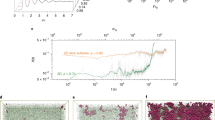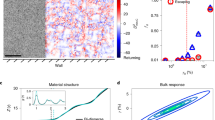Abstract
Understanding the mechanical properties of glasses is a great scientific challenge. A powerful technique to study the material response on a microscopic scale is microrheology, in which one analyses the translational dynamics of an externally driven probe particle. Here we show that the translational and rotational dynamics of a self-propelled probe particle with an unconstrained orientational motion can be used to gather information about the mechanical properties of a colloidal glassy system. We find that its rotational diffusion coefficient continuously increases towards the glass transition and drops down in the glassy state. Such unexpected behaviour demonstrates a strong coupling mechanism between the orientation of the active probe particle and the glassy structure, which can be well described by a simple rheological model. Our results suggest that active probe particles may be useful for the micromechanical characterization of complex materials.
This is a preview of subscription content, access via your institution
Access options
Access Nature and 54 other Nature Portfolio journals
Get Nature+, our best-value online-access subscription
$29.99 / 30 days
cancel any time
Subscribe to this journal
Receive 12 print issues and online access
$259.00 per year
only $21.58 per issue
Buy this article
- Purchase on Springer Link
- Instant access to full article PDF
Prices may be subject to local taxes which are calculated during checkout




Similar content being viewed by others
Data availability
The data that support the findings of this study are available from the corresponding author upon reasonable request.
References
Berthier, L. & Biroli, G. Theoretical perspective on the glass transition and amorphous materials. Rev. Mod. Phys. 83, 587–645 (2011).
Berthier, L., Biroli, G., Bouchaud, J.-P., Cipelletti, L. & van Saarloos, W. Dynamical Heterogeneities in Glasses, Colloids, and Granular Media (Oxford Univ. Press, 2011).
Hunter, G. L. & Weeks, E. R. The physics of the colloidal glass transition. Rep. Prog. Phys. 75, 066501 (2012).
Pusey, P. N. & van Megen, W. Phase behaviour of concentrated suspensions of nearly hard colloidal spheres. Nature 320, 340–342 (1986).
Brambilla, G. et al. Probing the equilibrium dynamics of colloidal hard spheres above the mode-coupling glass transition. Phys. Rev. Lett. 102, 085703 (2009).
Stevenson, J. D., Schmalian, J. & Wolynes, P. G. The shapes of cooperatively rearranging regions in glass-forming liquids. Nat. Phys. 2, 268–274 (2006).
Candelier, R. et al. Spatiotemporal hierarchy of relaxation events, dynamical heterogeneities, and structural reorganization in a supercooled liquid. Phys. Rev. Lett. 105, 135702 (2010).
Spaepen, F. Homogeneous flow of metallic glasses: a free volume perspective. Scr. Mater. 54, 363–367 (2006).
Cubuk, E. D. et al. Structure–property relationships from universal signatures of plasticity in disordered solids. Science 358, 1033–1037 (2017).
Gokhale, S., Hima Nagamanasa, K., Ganapathy, R. & Sood, A. K. Growing dynamical facilitation on approaching the random pinning colloidal glass transition. Nat. Commun. 5, 4685 (2014).
Zylberg, J., Lerner, E., Bar-Sinai, Y. & Bouchbinder, E. Local thermal energy as a structural indicator in glasses. Proc. Natl Acad. Sci. USA 114, 7289–7294 (2017).
Squires, T. M. & Brady, J. F. A simple paradigm for active and nonlinear microrheology. Phys. Fluids 17, 073101 (2005).
Shore, K. A. & Alan Shore, K. Microrheology, by E. M. Furst and T. M. Squires. Contemp. Phys. 59, 222–223 (2018).
Habdas, P., Schaar, D., Levitt, A. C. & Weeks, E. R. Forced motion of a probe particle near the colloidal glass transition. Europhys. Lett. 67, 477–483 (2004).
Winter, D., Horbach, J., Virnau, P. & Binder, K. Active nonlinear microrheology in a glass-forming Yukawa fluid. Phys. Rev. Lett. 108, 028303 (2012).
Wilson, L. G., Harrison, A. W., Poon, W. C. K. & Puertas, A. M. Microrheology and the fluctuation theorem in dense colloids. Europhys. Lett. 93, 58007 (2011).
Gruber, M., Abade, G. C., Puertas, A. M. & Fuchs, M. Active microrheology in a colloidal glass. Phys. Rev. E 94, 042602 (2016).
Puertas, A. M. & Voigtmann, T. Microrheology of colloidal systems. J. Phys. Condens. Matter 26, 243101 (2014).
Bechinger, C. et al. Active particles in complex and crowded environments. Rev. Mod. Phys. 88, 045006 (2016).
Hertlein, C., Helden, L., Gambassi, A., Dietrich, S. & Bechinger, C. Direct measurement of critical Casimir forces. Nature 451, 172–175 (2008).
Gomez-Solano, J. R. et al. Tuning the motility and directionality of self-propelled colloids. Sci. Rep. 7, 14891 (2017).
Buttinoni, I., Volpe, G., Kümmel, F., Volpe, G. & Bechinger, C. Active Brownian motion tunable by light. J. Phys. Condens. Matter 24, 284129 (2012).
Edmond, K. V., Elsesser, M. T., Hunter, G. L., Pine, D. J. & Weeks, E. R. Decoupling of rotational and translational diffusion in supercooled colloidal fluids. Proc. Natl Acad. Sci. USA 109, 17891–17896 (2012).
Debenedetti, P. G. & Stillinger, F. H. Supercooled liquids and the glass transition. Nature 410, 259–267 (2001).
van Megen, W., Mortensen, T. C., Williams, S. R. & Müller, J. Measurement of the self-intermediate scattering function of suspensions of hard spherical particles near the glass transition. Phys. Rev. E 58, 6073–6085 (1998).
Brady, J. F. Particle motion driven by solute gradients with application to autonomous motion: continuum and colloidal perspectives. J. Fluid Mech. 667, 216–259 (2010).
Deshpande, A. P., Murali Krishnan, J. & Kumar, S. Rheology of Complex Fluids (Springer, 2010).
Raikher, Y. L., Rusakov, V. V. & Perzynski, R. Brownian motion in a viscoelastic medium modelled by a Jeffreys fluid. Soft Matter 9, 10857–10865 (2013).
Yan, W. & Brady, J. F. The swim force as a body force. Soft Matter 11, 6235–6244 (2015).
Ke, H. B., Zeng, J. F., Liu, C. T. & Yang, Y. Structure heterogeneity in metallic glass: modeling and experiment. J. Mater. Sci. Technol. 30, 560–565 (2014).
Jiang, H.-R., Yoshinaga, N. & Sano, M. Active motion of a Janus particle by self-thermophoresis in a defocused laser beam. Phys. Rev. Lett. 105, 268302 (2010).
Yan, J. et al. Reconfiguring active particles by electrostatic imbalance. Nat. Mater. 15, 1095–1099 (2016).
Fuller, G. G. & Vermant, J. Complex fluid–fluid interfaces: rheology and structure. Annu. Rev. Chem. Biomol. Eng. 3, 519–543 (2012).
Angelini, T. E. et al. Glass-like dynamics of collective cell migration. Proc. Natl Acad. Sci. USA 108, 4714–4719 (2011).
Ni, R., Cohen Stuart, M. A. & Dijkstra, M. Pushing the glass transition towards random close packing using self-propelled hard spheres. Nat. Commun. 4, 2704 (2013).
Berthier, L. Nonequilibrium glassy dynamics of self-propelled hard disks. Phys. Rev. Lett. 112, 220602 (2014).
Stenhammar, J., Wittkowski, R., Marenduzzo, D. & Cates, M. E. Activity-induced phase separation and self-assembly in mixtures of active and passive particles. Phys. Rev. Lett. 114, 018301 (2015).
Ni, R., Cohen Stuart, M. A., Dijkstra, M. & Bolhuis, P. G. Crystallizing hard-sphere glasses by doping with active particles. Soft Matter 10, 6609–6613 (2014).
Lauga, E. Propulsion in a viscoelastic fluid. Phys. Fluids 19, 083104 (2007).
Bi, D. & Yang, X., Marchetti, M. C. & Manning, M. L. Motility-driven glass and jamming transitions in biological tissues. Phys. Rev. X 6, 021011 (2016).
Verstraeten, N. et al. Living on a surface: swarming and biofilm formation. Trends Microbiol. 16, 496–506 (2008).
Acknowledgements
The authors acknowledge helpful discussions with Th. Voigtmann, M. Fuchs, D. Levis and J. Berner. We thank H.-J. Kümmerer and C. Mayer for their technical support. C.B. acknowledges financial support from the German Research Foundation (DFG) through the priority programme SPP 1726 on microswimmers and by the ERC Advanced Grant ASCIR (grant no. 693683). J.R.G.-S. was supported by DFG grant no. GO 2797/1-1.
Author information
Authors and Affiliations
Contributions
C.L. and C.B. designed the research and wrote the paper; C.L. carried out the experiments and analysed the data; J.R.G.-S. performed the simulations.
Corresponding author
Ethics declarations
Competing interests
The authors declare no competing interests.
Additional information
Publisher’s note: Springer Nature remains neutral with regard to jurisdictional claims in published maps and institutional affiliations.
Supplementary information
Supplementary Information
Supplementary Figs. 1–5.
Rights and permissions
About this article
Cite this article
Lozano, C., Gomez-Solano, J.R. & Bechinger, C. Active particles sense micromechanical properties of glasses. Nat. Mater. 18, 1118–1123 (2019). https://doi.org/10.1038/s41563-019-0446-9
Received:
Accepted:
Published:
Issue Date:
DOI: https://doi.org/10.1038/s41563-019-0446-9
This article is cited by
-
Visualizing slow internal relaxations in a two-dimensional glassy system
Nature Physics (2023)
-
Unjamming and emergent nonreciprocity in active ploughing through a compressible viscoelastic fluid
Nature Communications (2022)
-
Bayesian inference of the viscoelastic properties of a Jeffrey’s fluid using optical tweezers
Scientific Reports (2021)
-
Anatomy of cage formation in a two-dimensional glass-forming liquid
Nature (2020)
-
Light-switchable propulsion of active particles with reversible interactions
Nature Communications (2020)



